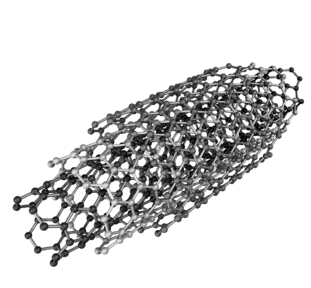Carbon Nanotubes Profile

OTHERS – MULTIPLE CLASSIFICATIONS (IARC 2B, 3)
Contents
Carbon Nanotubes Profile
QUICK SUMMARY
- Manufactured materials commonly used for structural reinforcement because they result in a product with high strength and low weight; has applications in nanotechnology, electronics, and optics
- Associated cancer: Specific types of CNTs are linked to lung cancer in animals
- Most important routes of exposure: Inhalation, skin contact
- Occupational exposures: Workers may be exposed when generating and applying the material, especially when handling it as a dry powder
- Environmental exposures: The general public may be exposed as CNT-containing consumer products weather over time
- Fast fact: CNTs have been called the “new asbestos”, but while they share similar properties to asbestos fibres, usage is not as widespread and the health risks are less well-understood.
General Information
Carbon nanotubes (CNTs) are a diverse group of materials made from graphene sheets, which are hollow filaments of carbon one-atom in thickness. They can be various lengths and sizes, depending on their end purpose and how they are produced. Single walled carbon nanotubes (SWCNT) are constructed with one cylindrical sheet of graphene, while multi walled carbon nanotubes (MWCNT) consist of multiple concentric tubes or layers of graphene.[1] In general, the outer diameter of MWCNT is 10–200 nm,[2] however this can vary based on the number of layers and atomic structure.
There is currently little evidence of carcinogenicity for SWCNT and MWCNT, which are currently classified by IARC as Group 3 (not classifiable as to their carcinogenicity to humans). One specific type of MWCNT called MWCNT-7 is classified as Group 2B (possibly carcinogenic to humans).[3,4] The MWCNT-7 type of nanotubes are long and narrow with similarities in form to asbestos fibres.[5] Research on rodents found that exposure to MWCNTs can cause mesothelioma (a cancer of the organ linings, especially lung) and lung cancer.[6,7,8] The ratio of nanotube length to width and curvature of the CNTs seems to be an important factor in determining carcinogenicity.[9]
Since nanotechnology is a relatively new field and there are many different types of carbon nanotubes, it is challenging to classify potential health risks. CNTs are different than carbon nano-fibres (CNFs) which are much larger and do not always have the same structure.[10] To date there is limited evidence of human health effects of CNTs, but studies on animals have found adverse pulmonary effects including inflammation, granulomas, and pulmonary fibrosis.[10]
Main Uses
CNTs are strong, flexible, lightweight, heat resistant, and have high electrical conductivity,[22,23] which makes them ideal for use in electronics (including tablets and phones), batteries, solar cells, automotive parts, sporting goods (tennis rackets, baseball bats, bicycle frames), bulletproof vests, polymer composites, adhesives, electronics, imaging, and inks.[10] CNTs are also used in pharmaceutical and biomedical devices for bone grafting, tissue repair, medical diagnosis, and drug delivery.[24] Another use of CNTs is in water filters to clean pollutants out of contaminated water,[25] however further research is needed to determine whether there are health and/or environmental consequences associated with this application. The physical properties of CNTs make them an ideal material for many applications and these uses are likely to continue to expand in the coming years.
Canadian Production and Trade
No information was available on the production and trade of carbon nanotubes in Canada.[26]
Environmental Exposures Overview
The most significant route of CNT exposure for the general Canadian population is likely inhalation.[27,28] This may occur through wear and tear of CNT products via contact with CNTs during usage or disposal.[29] Release of CNTs has also been reported during the burning of natural gas, propane, and methane gases via indoor gas stoves for cooking, but also via outdoor industrial burning sites.[30,31]
Occupational Exposures Overview
The main route of occupational exposure is inhalation, however dermal exposure may also occur. Research and development along with manufacturing and applications are sites where higher airborne exposure may occur.[10] CNTs can enter the air during activities such as drilling and cutting, and while transferring, blending, and mixing the powders.[10] Having proper ventilation, using a respirator, wearing protective clothing (gloves, eyewear), showering, and changing clothes at the end of the workday are recommended methods to minimize exposure in the occupational setting. It’s also important to not consume food or beverages in areas where CNTs are constructed or handled, as this is another way they can enter your body.[10]
Sources
Photo: Wikimedia Commons, Eric Wieser
Subscribe to our newsletters
The CAREX Canada team offers two regular newsletters: the biannual e-Bulletin summarizing information on upcoming webinars, new publications, and updates to estimates and tools; and the monthly Carcinogens in the News, a digest of media articles, government reports, and academic literature related to the carcinogens we’ve classified as important for surveillance in Canada. Sign up for one or both of these newsletters below.
CAREX Canada
School of Population and Public Health
University of British Columbia
Vancouver Campus
370A - 2206 East Mall
Vancouver, BC V6T 1Z3
CANADA
As a national organization, our work extends across borders into many Indigenous lands throughout Canada. We gratefully acknowledge that our host institution, the University of British Columbia Point Grey campus, is located on the traditional, ancestral and unceded territories of the xʷməθkʷəy̓əm (Musqueam) people.


